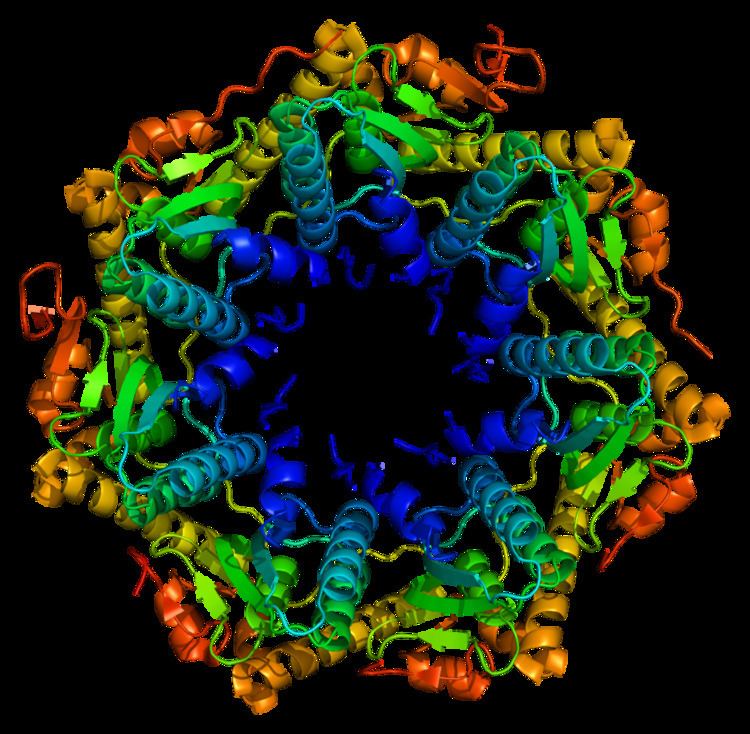Entrez 8192 | Ensembl ENSG00000125656 | |
 | ||
Aliases CLPP, PRLTS3, DFNB81, caseinolytic mitochondrial matrix peptidase proteolytic subunit External IDs MGI: 1858213 HomoloGene: 4385 GeneCards: CLPP | ||
ATP-dependent Clp protease proteolytic subunit (ClpP) is an enzyme that in humans is encoded by the CLPP gene. This protein is an essential component to form the protein complex of Clp protease (Endopeptidase Clp).
Contents
Structure
Enzyme ClpP is a highly conserved serine protease present throughout bacterial and also found in the mitochondria and chloroplasts of eukaryotic cells. The ClpP monomer is folded into three subdomains: the "handle", the globular "head", and the N-terminal region. By itself, ClpP can assemble into a tetradecamer complex (14-members) and form a closed proteolytic chamber. A fully assembled Clp protease complex has a barrel-shaped structure in which two stacked ring of proteolytic subunits (ClpP or ClpQ) are either sandwiched between two rings or single-caped by one ring of ATPase-active chaperon subunits (ClpA, ClpC, ClpE, ClpX or ClpY). ClpXP is presented in almost all bacteria while ClpA is found in the Gram-negative bacteria, ClpC in Gram-Positive bacteria and cyanobacteria. ClpAP, ClpXP and ClpYQ coexist in E. Coli while only ClpXP complex in present in humans.
Function
In bacteria, it was shown that ClpP is capable to cleave full-length proteins without being associated with ClpA but the degradation is at a much slower rate. Fully functional Clp protease requires the participation of AAA+ ATPase. These ClpX Chaperons recognize, unfold and transfer protein substrates to proteolytic core formed by ClpP tetradecamer. The proteolytic sites of ClpP subunits contain hydrophobic grooves which recruit substrate and host the catalytic triad Asp-His-Ser. In several bacteria, such as E. coli, proteins tagged with the SsrA peptide (ANDENYALAA) encoded by tmRNA are digested by Clp proteases.
The protein encoded by this gene belongs to the peptidase family S14 and hydrolyzes proteins into small peptides in the presence of ATP and magnesium. The protein is transported into mitochondrial matrix and is associated with the inner mitochondrial membrane.
Clinical Significance
ClpP protease is a major contributor for mitochondrial protein quality control system and removed damaged or misfolded proteins in mitochondrial matrix. Defects in mitochondrial Clp proteases have been associated with the progression of neurodegenerative diseases while upregulation of ClpP proteases has been implicated in preventing premature aging. Recessive CLPP mutations were recently observed in the human Perrault variant associating with ovarian failure and sensorineural hearing loss, in parallel with growth retardation. The clinical phenotype was accompanied by the accumulation of ClpP associating partner chaperon ClpX, mtRNA, and inflammatory factors. The disease pathological cause probably involves deficient clearance of mitochondrial components and inflammatory tissue destruction.
